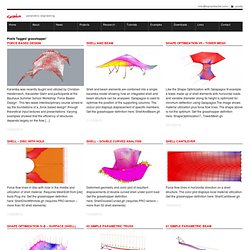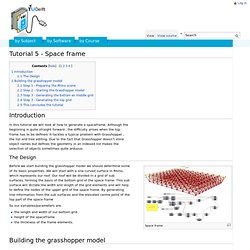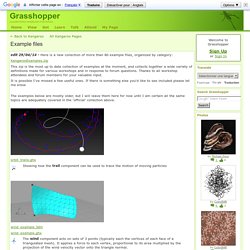

Canopy Explorations. Grasshopper. Posts Tagged ‘grasshopper’ Force Based Design Karamba was recently taught and utilized by Christian Heidenreich, Alexander Stahr and participants at the Bauhaus Summer School Workshop ‘Force Based Design’.

This two-week interdisciplinary course aimed to lay the foundations of a „force based design“ through theoretical input lectures and presentations. Varying examples showed that the efficiency of structures depends largely on the flow […] Shell And Beam Shell and beam elements are combined into a single karamba model showing how an integrated shell and beam structure can be analysed. Shape Optimization VII – Tower Mesh Like the Shape Optimization with Galapagos III example, a tower made up of shell elements with horizontal loads and variable diameter along its height is optimized for minimum deflection using Galapagos.The image shows material utilization plus force flow lines.
Shell – Disc with Hole Force flow lines in disc with hole in the middle and utilization of shell material. Tutorial 5 - Space frame. In this tutorial we will look at how to generate a spaceframe.

Although the beginning is quite straight forward , the difficulty arises when the top frame has to be defined. It tackles a typical problem with Grasshopper , the list and tree editing. Due to the fact that Grasshopper doesn't store object names but defines the geometry in an indexed list makes the selection of objects sometimes quite arduous. The Design Space frame Before we start building the grasshopper model we should determine some of its basic properties. So our variables/parameters are: the length and width of our bottom grid height of the spaceframe the thickness of the frame elements.
Step 1 - Preparing the Rhino scene. Example files. Edit 29/04/14 - Here is a new collection of more than 80 example files, organized by category: This zip is the most up to date collection of examples at the moment, and collects together a wide variety of definitions made for various workshops and in response to forum questions.

Thanks to all workshop attendees and forum members for your valuable input. It is possible I've missed a few useful ones. If there is something else you'd like to see included please let me know The examples below are mostly older, but I will leave them here for now until I am certain all the same topics are adequately covered in the 'official' collection above. Showing how the trail component can be used to trace the motion of moving particles The wind component acts on sets of 3 points (typically each the vertices of each face of a triangulated mesh). CurvePull - Pulls particles onto a curve. The Vortex component rotates one particle about an axis defined by 2 points. (also requires WeaverBird) drape_example.gh. Blogs. About Generative Design platforms by Mark Loomis. (image from Bentley)This is a guest post from Mark Loomis First off, I want to thank Rodrigo Medina for graciously inviting me to guest post on his blog.

I’m Mark Loomis, a landscape architect who first learned about generative design when I read this article by Angus Stocking about a year ago. Since then I’ve been learning all I can about it and this post is an encapsulation of my findings. I’ve also started my own company, called Parametric Concepts, in order to pursue this new design paradigm. I’m by no means an expert at any of it but my research has given me a pretty good overall view of what’s out there. Object based geometry population starts with a predetermined overall form and uses the software to populate desired geometries over the surface of that form. Scripting involves writing code that generates geometry following constraints and parameters. I highly recommend that you invest in Rhino. I also recommend that you download GenerativeComponents. Definitions. Modeling. Rhino/Grasshopper.
Grasshopper tutorials.